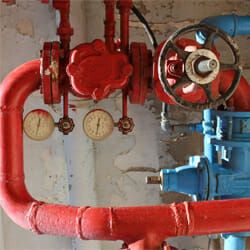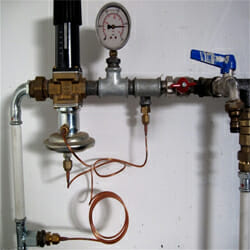Your hot water tank might appear to be another appliance when you look at it, but in engineering, this type of part is known as a pressure vessel. A pressure vessel is a special container designed to keep gases or liquids at a pressure significantly higher than the surrounding atmosphere.
Pressure vessels have a lot of rules and regulations established concerning them because, if they don’t have the proper safety features installed, they can be pretty dangerous. The vessel has the potential to explode like a bomb if the adequate pressure safety valve is not there to release pressure when it starts to build above the set limits.
However, you do not have to worry because your house has a hot water tank. Water heaters have various safety features to prevent over pressurizing. Still, installing a proper temperature and pressure relief valve (TPR valve) on your hot water tank or boiler is important. The TPR valve is a safety valve that opens and releases pressure when the temperature and pressure within the tank reach a dangerous level.
What is a TPR Valve?
A TPR valve, or temperature and pressure relief valve, is a small safety valve that is installed on water heaters and boilers. It is designed to open automatically and release pressure or temperature buildup that can harm people or property.
This valve helps prevent explosions and scalding water. Its purpose is to relieve the system’s pressure and/or temperature buildup due to problems, including broken thermostats, clogged water lines, or other issues. The valve automatically opens when the system’s temperature or pressure rises above a specific threshold.
Once the valve opens, water is discharged from the system, bringing the pressure and temperature down to a safe level.
How Does a TPR Valve Work
A TPR valve is typically a small brass or copper valve installed on the top or side of a water heater or boiler. The valve is connected to a discharge pipe, typically made of copper, PVC, or another suitable material. The discharge pipe should be directed towards a safe area where any released water will not cause damage or harm to people or property.
The TPR valve works using a spring-loaded mechanism that opens the valve when the pressure or temperature within the system reaches a critical level. The spring is designed to keep the valve closed under normal operating conditions. However, if the pressure or temperature within the system exceeds the set limit, the spring will compress, and the valve will open, releasing water from the system.
The TPR valve is designed to operate at a specific pressure and temperature range, typically indicated on the valve itself. It is important to check the rating of your water heater and choose a TPR valve that will open at or below the tank’s maximum pressure and temperature limits. Keep in mind that different tanks and components may have different requirements.
How to Test Your TPR Valve
Testing your TPR (Temperature and Pressure Relief) valve is essential to home maintenance. It ensures that the valve functions correctly and can help prevent potential accidents and damage to your home. Here’s how to test your TPR valve:
- Turn off the Power Supply: Before testing your TPR valve, turn off the power supply to your water heater or boiler. Turn off the gas supply if you have a gas-powered water heater or boiler.
- Locate the TPR valve: Normally, the TPR valve is found on the top or side of the boiler or water heater. It has a lever or handles on top and a discharge pipe running down the tank’s side.
- Prepare a bucket or container: Place a bucket or container under the discharge pipe to catch any water that may come out during the test.
- Lift the TPR valve lever: Pull up on the lever or handle on top of the TPR valve. You should hear a rush of water as the valve opens and water flows into the bucket or container.
- Observe the discharge: The water from the discharge pipe should be hot and steamy. If the water is cool or the valve does not release water, it may indicate that the valve is not functioning correctly and needs to be replaced.
- Release the lever: Once the test is complete, release the lever or handle on the TPR valve. The valve should snap back into place, stopping the flow of water.
- Turn the power supply back on. Once the test is complete, return the power supply to your water heater or boiler.
To make sure it works properly, test your TPR valve at least once a year.
Also Read: How to Turn Off Your Water Heater Shut Off Valve
3 Ways in which a TPR Valve Keeps Us Safe
A TPR valve, or temperature and pressure relief valve, keeps us safe in the following ways:

The TPR valve is built to open automatically and discharge pressure or temperature accumulation when it reaches a dangerous level, preventing overheating. This prevents the tank from heating up excessively and blowing up, which may be dangerous.
Hot water can cause severe burns, and if the TPR valve is not installed or is not functioning correctly, it can result in serious injury or death. The TPR valve helps prevent scalding water from being released from the system, keeping us safe from burns.
A TPR valve helps prevent overheating and scalding by releasing excess temperature and pressure from the water heater or boiler. Regular maintenance and testing are necessary to ensure that the TPR valve is functioning correctly and can help identify potential issues before they cause overheating and scalding accidents.
Additionally, the TPR valve can act as a warning sign if something is wrong with the water heater or boiler.
Reduces Damage to Property
If the pressure or temperature within the system becomes too high, it can cause the tank to rupture, leading to potential explosion and fire. The TPR valve releases excess pressure and temperature from the system, reducing the risk of property damage.
Many jurisdictions require the installation of a TPR valve on all water heaters and boilers. This is because the valve is an essential safety device that can prevent catastrophic failure of these systems, which can cause property damage and harm to individuals.
A TPR valve helps reduce damage to property by releasing excess pressure and temperature, preventing tank overheating, and directing hot water and steam away from the tank. Regular maintenance and testing are necessary to ensure that the TPR valve is functioning correctly and can help identify potential issues before they cause property damage.
Ensures Proper Drainage
A TPR valve ensures proper drain flow without restrictions by being installed with a properly sized discharge pipe free from obstructions. The discharge pipe should be installed to allow the safe and unrestricted flow of water and steam.
Regular maintenance and testing are also necessary to ensure the valve and discharge pipe function correctly. A TPR valve must be installed with a discharge pipe that meets specific requirements to ensure proper drainage.
The pipe should be the correct size and length and made of a material that can withstand high temperatures and pressure. It should be directed downward and terminated safely, such as in a floor drain or outside.
If the TPR valve works properly, it will release hot water and steam through the discharge pipe, safely carrying the water and steam away from the tank. This prevents the tank from overheating and helps prevent damage or injury.
Understand Your TPR Valve in Case of Emergencies

- Know the location of your TPR valve: The TPR valve is typically located on the top or side of the water heater or boiler and may be labelled.
- Understand how it works: The TPR valve is designed to release pressure and temperature from the system when it reaches dangerous levels. If the valve works correctly, you may hear a hissing sound or see steam or hot water discharge from the valve.
- Be prepared for emergencies: If you hear the TPR valve hissing or see water or steam coming from the valve, it is important to act quickly. Turn off the power or fuel supply to the water heater or boiler, and close the water supply valve to prevent additional water from entering the tank.
- Call for help: After taking these steps, call a qualified plumber or HVAC technician to inspect the system and repair or replace the TPR valve as needed.
- Regular maintenance: Regular maintenance and testing of the TPR valve are essential to ensure it functions correctly. The valve should be tested at least once a year, and the discharge pipe should be checked for obstructions.
In summary, understanding your TPR valve’s location, function, and maintenance is essential to ensuring your safety in emergencies. If you hear the valve hissing or see water or steam coming from the valve, take immediate action to prevent further damage and call for professional help.
Related Articles:
A licensed plumber will always have the required tools for installation and replacement. We have tried our best to discuss a TPR Valve and its functioning in detail, but you can always contact Damien McEvoy for any issues. Especially if you are in Sutherland, call us. We will be available to help you and provide the best solution for your needs.



 Enquire
Enquire